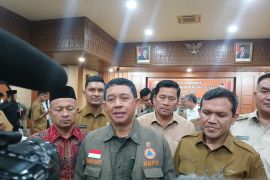"Until the second dasarian (a ten-day period) of October 2023, El Nino is at a moderate level and the Indian Ocean Dipole (IOD) remains positive,” Head of BMKG Dwikorita Karnawati stated in Jakarta on Thursday.
She said the BMKG and several other World Climate Centers project that El Nino will remain at a moderate level until the period of December 2023-January-February 2024, whereas positive IOD will remain until the end of 2023.
The condition will influence several sectors, such as agriculture, water resources, forestry, trade, energy, and health, she remarked.
“Thus, the government at all levels is expected to take steps to mitigate and anticipate negative impacts that might happen,” she noted.
Karnawati cautioned that in the agriculture sector, food crop production is threatened to decrease due to disturbed planting cycles, crop failure, the lack of resilience in some plants, or the spread of pests that are active during dry conditions.
In the water resources sector, this situation might lead to a decrease in water, whereas in the trade sector, it might trigger an increase in food prices, she stated.
Furthermore, in the forestry sector, it might cause wildfires. In the energy sector, it might lessen hydroelectric energy production.
Related news: El Nino: President stresses securing water supply
In the defense sector, the condition increases the risk of health complications due to sanitation and a lack of clean water for consumption and hygiene.
“In regions that experience wildfires, this condition leads to air pollution and triggers acute respiratory infections (ISPA),” she stated.
Karnawati stated that the government can implement some strategies in an effort to mitigate the situation, with the first being strengthening water management.
The second strategy is by intensifying the dissemination of information and guidelines for farmers to adapt to the shift in seasonal patterns and select plants that are more resilient to drought.
The third approach is conducting counseling and training programs to help communities adopt an agricultural practice that is more resilient to droughts.
Under the fourth strategy, forest and land management is strengthened to prevent wildfires triggered by the dry weather.
The fifth strategy entails implementing an ecosystem rehabilitation program and land restoration for lands that have degraded due to droughts and wildfires.
The sixth approach involves setting a logistical preparation plan to ensure the supply of clean water and food, especially in vulnerable areas.
The seventh approach necessitates conducting a community awareness campaign about water conservation practices and ways to reduce the risks of disasters.
Related news: Govt to anticipate drought through clean, drinking water provision
Related news: Nearly 50 million Indonesians threatened by extreme drought
Translator: Zubi, Luthfia, Azis Kurmala
Editor: Yuni Arisandy Sinaga
Copyright © ANTARA 2023











